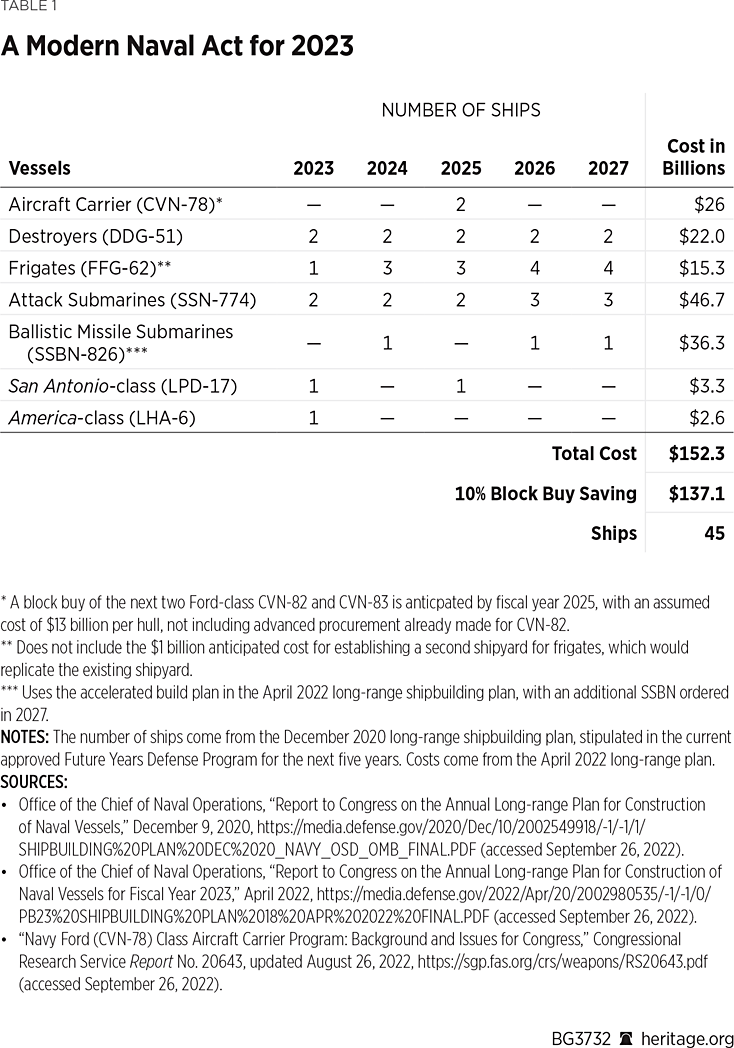China’s increasing belligerence and Russia’s flagrant violations of long-standing international borders in Ukraine have shone a spotlight on America’s weak defense posture. Sadly, the nation’s first line of defense and most effective means of distant deterrence of Chinese adventurism, the U.S. Navy, has been unable to build the fleet needed to confront this rapidly changing world.
History provides a model for galvanizing public attention for political action. The Naval Act of 1938 is one such example. A new version of the act could put naval shipbuilding on course to deliver the Navy the nation needs, expand the necessary industrial capacity, and do it all economically using good business practices. Arguably the nation has the resources needed to do this and needs only a reprioritization of where limited dollars are spent. Sadly, despite the dangers of the day, conventional government resourcing of the Navy has not delivered. A new naval act is needed.
The Danger Is Closer Than Most Think
Today, the nation confronts a rapidly deteriorating security environment, much as it did in 1938. Increasingly, policymakers agree that China plans to attack Taiwan this decade, with some predicting conflict by 2027.REF As Admiral Philip Davidson, then Commander of U.S. military forces in the Indo-Pacific, testified March 2021 before Congress:
Taiwan is clearly one of their ambitions before then, and I think the threat is manifest during this decade, in fact, in the next six years.REF
America should act now to meet this threat. Critically, expanding shipbuilding capacity will take two to three years as the Pentagon identifies vendors to produce military-grade materials. Shipyard construction capacities will likely take longer to expand. Congress should pass legislation in the 118th Congress (2023–2025) to prepare for a potential showdown with China in 2027.
A war with China would be decided at sea, and an American victory will depend on having adequate naval forces. For the communists, victory over Taiwan requires sustaining a successful amphibious assault while preventing U.S. military forces from cutting them off. To do this, the Chinese have built a massive armada of ships, aircraft, and ballistic missiles to suppress land-based threats and hunt down U.S. naval vessels.REF They know that securing the waters around Taiwan is key to their eventual victory. Today the U.S. Navy is inadequate to the task and trending in the wrong direction, as tracked annually since 2015 in The Heritage Foundation’s Index of U.S. Military Strength.REF This situation—and the uncertainty of how a modern naval war may play out—makes it imperative to rebuild a robust shipbuilding industry.
Plans to Nowhere: Navy’s 30-Year Shipbuilding Legacy of Undelivered Promises
The Office of Naval Intelligence, which tracks China’s naval modernization, assessed that, from 2000 to 2020, China grew its battle fleet by 150, while the U.S. fleet shrank by 21 warships to 297.REF Frustration with this warfighting imbalance has resulted in Congress mandating force levels, as in the 12 Carrier Act of 2019, or in 2016 legislating a fleet of 355 warships sometime in the future—but neither piece of legislation was accompanied by the necessary funding or broad political support.REF
Even though for 20 years the Navy’s own goals have been for a fleet above 300 ships, the Navy has averaged 10 ships below its own procurement plans since 2017 and has sustained fewer than 300 warships since 2003.REF To make matters worse, a third of today’s Reagan-era fleet will reach end of service life by 2030.REF
A Modern Naval Act
Today’s domestic shipbuilding predicament is not unlike that of the late 1930s: a lackluster defense industrial base, war in Europe, and looming threats in Asia. Reflecting on the success of the nation’s pre–World War II industrial mobilization, one of its architects, Bill Knudsen, attributed it simply to placing orders and getting out of industry’s way.REF
Then, as now, the need for a strong national defense has been an area of bipartisan agreement, and the Naval Act was a great example of such cooperation. For the Navy, Representative Carl Vinson, a Georgia Democrat, was instrumental in kickstarting naval shipbuilding in the lead-up to war. As chair of the House Naval Affairs Committee (1931–1947), he worked closely with the Senate’s Naval Affairs Committee chair, Florida Republican Senator Park Trammell. Eventually, Vinson convinced the White House to support additional funding of the Navy, and he is credited with the Naval Acts of 1934 and 1938.REF
The Naval Act of 1938 delivered Iowa-class battleships, Atlanta-class light cruisers, and the carrier Hornet at a critical moment. But more than that, it began an expansion of American naval shipbuilding that would eventually deliver over 6,000 warships—including 94 new aircraft carriers—by the war’s end in 1945.REF
However, simply replicating a naval act will not be effective. For one, today’s Pentagon budgeting and planning processes are much changed, notably by the Goldwater–Nichols Act of 1986. An updated naval act is needed to effectively channel growing congressional support for a strong national defense, evident in its raising defense budgets above President Joe Biden’s proposals.
Unleashing Market Forces for Expanded Naval Shipbuilding Requires Predictability
Matthew Paxton, president of the Shipbuilders Council of America, told Congress in 2017 that achieving the then-stated goal of a 355-ship fleet requires “stable and robust funding…to sustain those industrial capabilities which support Navy shipbuilding and ship maintenance and modernization.”REF More recently, Chief of Naval Operations Admiral Michael Gilday has voiced concerns over a shipbuilding industry that lacks the capacity to build and support a larger fleet:REF
We need to give a signal to industry that we need to get to three destroyers a year, instead of 1.5, that we need to maintain two submarines a year. And so part of this is on us to give them a clear set of—a clear aim point so they can plan a work force and infrastructure that’s going to be able to meet the demand. But again, no industry is going to make those kinds of investments unless we give them a higher degree of confidence.REF
To reverse these downward trends, Gilday has on multiple occasions asserted that his budget will need sustained year-on-year growth of 3 percent to 5 percent above inflation.REF Moreover, the impending production of Columbia-class ballistic missile submarines, costing $15 billion for the lead ship, pose additional challenges to a constrained shipbuilding budget of $27 billion to $33 billion annually through 2027.REF The Ohio-class ballistic submarines retire this decade, so the Columbia-class are a must buy item. To make matters worse, budgets have not been passed on time in 11 of past 12 years, which has negatively impacted contracting for new shipbuilding.REF To get needed fiscal predictability and sustainability through 2027 would require shipbuilding contracts in excess of $150 billion—not likely to be absorbed in the annual defense budget.REF
Marrying Political Will with Smart Resourcing
Naval shipbuilding should be elevated to its own legislative act based on proven block buys with firm, fixed-price contracting and full funding. So, what are these mechanisms and why would they work?
Firm, Fixed Price. Naval shipbuilding contracts are typically fixed-price-incentive contracts. The Navy assumes some risk, and this has been found to contribute to underbidding, late delivery, and questionable incentives.REF While this system is appropriate for some naval shipbuilding contracts, firm, fixed-price contracts—which is prevalent in commercial shipbuilding—make more sense for stable naval warship designs. In fact, the Navy has used it for two non-combatant ships since 2005.REF Such contracting sets a price, with the shipbuilder accepting risks and costs for needed infrastructure and workforce investments. For the taxpayer, the trade-off is higher up-front bids by shipbuilders, which is mitigated by less long-term risk and less exposure to inflationary pressures.
Full Funding. Full funding for naval shipbuilding had been the norm since 1950 but fell out of favor amidst post–Cold War smaller annual budgets and rising costs. In turn, this drove Congress and the Navy to spread expenses over several years—consequentially complicating Congress’s oversight.REF As the formal Office of Management and Budget policy stipulates, full funding covers the full cost of a project, preferably in the year a procurement decision is made.REF
Block Buy. The Navy’s first block buy was fiscal year 1998, when it contracted for building the first four Virginia-class submarines, promising payments year-to-year as funds appropriated from Congress.REF The idea is that companies invest in additional capital infrastructure based on their marginal revenue or anticipated profits.REF For example, procurement of the second through sixth Navy oilers saved about $45 million per ship, of which $10 million was directly attributed to being a block buy.REF And today, a $2.9 billion to $4 billion savings is anticipated from the block buy of two Ford-class aircraft carriers in fiscal year 2020.REF The Navy has indicated to the Congressional Budget Office that block buys could save taxpayers from 5 percent to 15 percent.REF However, such savings assume that the President honors the contracts and Congress appropriates the annual monies, but the track record proves that such assurances are not the norm.
Recommendations
Inspired by the successful Naval Act of 1938 and leveraging savings of block buys, Congress should:
Create a Naval Act of 2023. This one-time legislation would authorize and appropriate needed funds for a large block buy for a new total of $152.3 billion before anticipated savings. (See Table 1.) Importantly, ships in this block buy would be of approved designs and in production today at numbers already stipulated in the current approved Future Years Defense Program that runs through 2027. That said, resourcing programs not listed or in development would still reside in the annual budget—the National Defense Authorization Act and associated appropriation bill.

Establish a Naval Affairs Executive Council. This council would conduct routine shipyard site inspections, formal confidential inquiries, and contract reviews and assess shipbuilding- and maintenance-capacity investments. It should be comprised of veterans of the shipbuilding industry and naval technical experts who make periodic reports and recommendations to Congress.
Conclusion
A 2023 naval act, as it did in 1938, can grow the nation’s naval shipbuilding capacity for a war that could occur with China this decade. As a discrete legislative act, it would draw attention to a national security priority while not competing directly with other military service budget needs. Fully funding a naval act in its first year is not a blank check: Congress’s oversight power over the act’s execution is left intact. It does this while further protecting shipbuilding from fluctuating and tardy budgets that have retarded needed capacity investments. A modern naval act, echoing the nation’s historic success in preparing for war in the Pacific, would galvanize meaningful action. Congress has indicated that it is willing to make the needed investments. A new naval act is one way of acting on that intention.
Brent D. Sadler is Senior Research Fellow for Naval Warfare and Advanced Technology in Center for National Defense at The Heritage Foundation.



